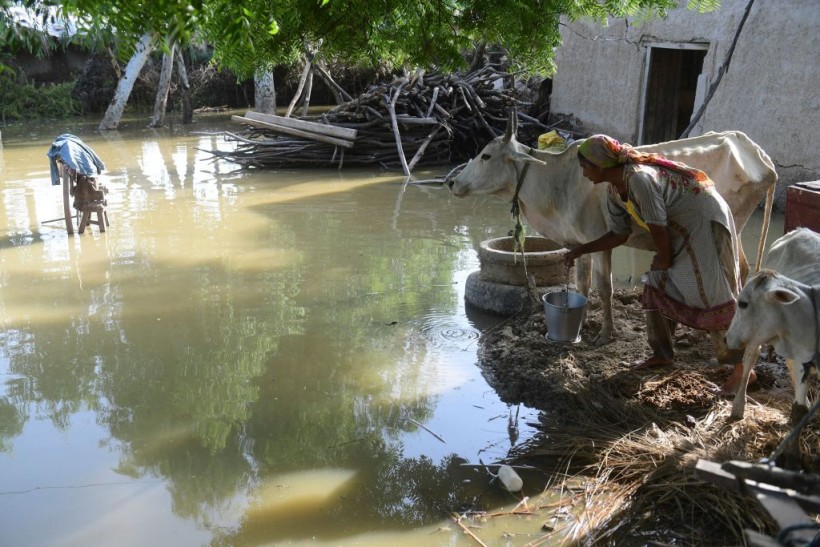Pakistan officials recently reported that over 1,000 people have died and millions displaced as flooding ruins the country.
The nation's leaders said the monsoon flooding this year has affected over 33 million people, once in seven Pakistanis, devastating or severely damaging almost a million homes, Mail Online reported.
Additionally, the country's climate minister called the fatal monsoon season a "severe climate catastrophe," while army chiefs called the catastrophe "unprecedented."
The unstoppable current of floodwater washed away whole villages, and a fearless army helicopter rescued to save stranded people moments before they got swept away.
ALSO READ: The World Meteorological Organization Reports the Consequences of Anthropogenic Climate Change

In this picture taken on August 28, 2022, Amina Khatoon holds a bucket of water next to a cow in her flood-damaged house on the outskirts of Sukkur, Sindh province. - The death toll from monsoon flooding in Pakistan has reached 1,061, according to figures released on August 29, 2022, by the country's National Disaster Management Authority.
Flash Flooding
In a media interview, Bilawal Bhutto-Zardari, Pakistan's Foreign Minister, said he has not seen the destruction of this scale and finds it quite difficult to put into words, adding, "it is overwhelming."
Flash flooding from heavy rains washed away villages and crops as rescue workers and soldiers evacuated stranded people to the safety of relief camps and provided food to thousands of displaced Pakistani people.
As shown in the footage, the army carried out a daring helicopter rescue to save stranded individuals from what seemed to be a "certain death."
The National Disaster Management Authority of Pakistan reported that the death toll had reached 1,033 people following reports of new deaths in Khyber Pakhtunkhwa and southern Sindh provinces.
The disaster body of the United Nations, the Office for the Coordination of Humanitarian Affairs, said that 184,000 individuals had been confirmed displaced, a number expected to increase in the coming days.
A related ABC News report said that floods were seen uprooting trees and sweeping away entire homes as the monsoon left entire communities devastated.
What Caused the Flash Floods in Pakistan?
A News9 report said that according to Pakistan's meteorological department, the monsoon in Pakistan begins in July and ends by September with an average normal rainfall of 140.8 millimeters.
Nonetheless, the monsoon has been extremely wet this year, with more than 370 millimeters of rainfall received until late last week, which is more than 2.6 times higher.
The highest rainfall has been recorded in the hilly Balochistan and Sindh, where millions of gallons of water washed down the mountains and rammed through residential areas, marketplaces, and agricultural fields.
Essentially, all major rivers in the north, such as the Kabul river, which flows from Afghanistan into Kyber Pakhtunkhwa, are encountering very high flood levels.
Effect of Climate Change
The devastation scale caused by the flooding is compared to an akin weather event in 2010 when nearly 2,000 people were killed.
The Earth's temperature has risen by 0.08 degrees Celsius every ten years since 1880, although the rate of warming has doubled since 1981.
This year, global warming was shown its brute face with record-breaking heat waves and flooding, putting it on the trajectory of one o the hottest years ever recorded.
A report about the recent Pakistan flooding is shown on CBS Evening News's YouTube video below:
RELATED ARTICLE: Over 2 Million Stranded, 57 Died in Bangladesh and India Flooding; What Could Have Caused the Floods?
Check out more news and information on Flooding in Science Times.














